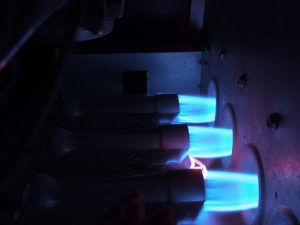 What type of heating system do you use to warm up your house during a tough Chicagoland winter? If your home is like the majority, the answer is a natural gas furnace. Gas furnaces are the most common type of residential heating system across the country, especially in locations with cold winters. Gas furnaces not only produce a large amount of heat, they do so at less expense than electric furnaces because natural gas costs less than electricity per unit.
What type of heating system do you use to warm up your house during a tough Chicagoland winter? If your home is like the majority, the answer is a natural gas furnace. Gas furnaces are the most common type of residential heating system across the country, especially in locations with cold winters. Gas furnaces not only produce a large amount of heat, they do so at less expense than electric furnaces because natural gas costs less than electricity per unit.
However, any natural gas appliance has the potential to develop safety hazards. We don’t want to alarm you, as a well-maintained gas furnace will rarely encounter dangers, and current furnace models are built with safety in mind and have special features to prevent the escape of carbon monoxide or a rise in combustion hazards.
There is one gas furnace problem we want to draw your attention to, because it’s the most common reason for a furnace allowing toxic gasses into a home: the cracked heat exchanger.
What’s a heat exchanger?
It’s basically what allows a furnace to heat up the air that travels through the ventilation system. When the burners of the furnace come up, they generate hot combustion gas which is collected inside the heat exchanger, which is a metal chamber or series of chambers. Most of them have a clam-shell shape. The hot combustion gas in the heat exchanger heats up the metal walls. The blower fan of the furnace then comes on and sends air around the exchanger, where it picks up the heat from the furnace wall, then continues into the ducts. In this way, the combustion gas heats the air without the gas having ever to come in contact with it.
Once the heating process is finished, the combustion byproducts in the heat exchanger are vented out of the system through a flue to release the gas harmlessly into the air.
The cracked heat exchanger
Because the metal of the heat exchanger expands and then contracts as it heats and cools, the stress may eventually cause a crack to form on the exchanger. Corrosion because of reaction between the combustion gas and the metal (often because of improper venting) can also weaken the metal to the point where cracks form.
These cracks may be small, but as the exchanger expand with the heat, they open enough to allow some of the combustion gasses to escape and enter the airflow. This means these harmful gasses will be sent through the house.
Warning signs
How can you tell you have a cracked heat exchanger? A major warning is if you hear a clicking sound from the furnace soon after the blower shuts off. This should always be investigated. If you see corrosion anywhere on the furnace, it’s also a sign of a problem—and you probably should have the furnace replaced at that point if it’s older than 15 years. If your CO alarms (carbon monoxide) go off, you’ll want to have a furnace expert check on the system once the initial danger is past. (Always have CO detectors if you use gas anywhere in your home!)
For fast repairs for a gas furnace in Wilmette, IL—or for any type of heating system!—look to us.
ServiceMax is open 24/7—All Day, Every Day!